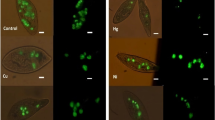Abstract
Callianassa australiensis (Dana) that survived 14 d acute lethality studies were analysed to determine the concentrations of zinc, cadmium and copper in the whole shrimp and in various parts of the body. Using regression analysis, the influence of each metal upon the uptake of the others was studied. Zinc and cadmium appeared to enhance the uptake of each other. In a mixture of zinc and copper, the uptake of zinc was enhanced and that of copper was inhibited. In a mixture of cadmium and copper, the uptake of copper was inhibited by the presence of cadmium, but cadmium uptake was unaffected in the presence of copper. In a mixture of all three metals, similar effects were observed except that zinc and copper, occurring together, appeared to have no effect upon cadmium uptake. Additional 14 d experiments with cadmium suggested that accumulation of this metal was a function of metal concentration in the water and of duration of exposure. The whole shrimp cadmium concentration also appeared to be a function of the size of the shrimp. The variation in concentration factors is described and the need for further research on the effects of combinations of metals on various organisms is emphasized.
Similar content being viewed by others
Literature Cited
Ahsanullah, M., D. S. Negilski and M. C. Mobley: Toxicity of zinc, cadmium and copper to the shrimp Callianassa australiensis I. Effects of individual metals. Mar. Biol. 64, 299–304 (1981)
Betzer, S. B. and M. E. Q. Pilson: Copper uptake and excretion by Busycon canaliculatum L. Biol. Bull. mar. biol. Lab., Woods Hole 148, 1–15 (1975)
Braek, G. S. and A. Jensen: Heavy metal tolerance of marine phytoplankton. III. Combined effects of copper and zinc ions on cultures of four common species. J. exp. mar. Biol. Ecol. 25, 37–50 (1976)
Bryan, G. W.: Heavy metal contamination in the sea. In: Marine pollution, pp 185–302. Ed. by R. Johnston. London, New York, San Francisco; Academic Press 1976
D'Agostino, A. and C. Finney: The effect of copper and cadmium on the development of Tigriopus japonicus. In: Pollution and physiology of marine organisms, pp 445–463. Ed. by F. J. Vernberg and W. B. Vernberg, New York: Academic Press, 1974
Eustace, I. J.: Zinc, cadmium, copper and manganese in species of finfish and shell fish caught in the Derwent estuary, Tasmania. Aust. J. mar. Freshwat. Res. 25, 209–220 (1974)
Fowler, S. W. and G. Benayoun: Experimental studies on cadmium flux through marine biota. In: Comparative studies of food and environmental contamination, pp 159–178. Vienna International Atomic Energy Agency 1974
McLusky, D. S. and C. N. K. Phillips: Some effects of copper on the polychaete Phyllodoce maculata. Estuar. cstl mar. Sci. 3, 103–108 (1975)
Negilski, D. S., M. Ahsanullah and M. C. Mobley: Toxicity of zinc, cadmium and copper to the shrimp Callianassa australiensis. II. Effects of paired and triad combinations of metals. Mar. Biol. 64, 305–309 (1981)
Nimmo, D. R., D. V. Lightner and L. H. Bahner: Effects of cadmium on the shrimp Penaeus duorarum, Palaemonetes pugio and Palaemonetes vulgaris. In: Physiological responses of marine biota to pollutants, pp 131–183. Ed. by F. J. Vernberg, A. Calabrese, F. P. Thurberg and W. B. Vernberg. New York, San Francisco, London: Academic Press Inc. 1977
Phillips, D. J. H.: The common mussel Mytilus edulis as an indicator of pollution by zinc, cadmium, lead and copper. I. Effects of environmental variables on uptake of metals. Mar. Biol. 38, 59–69 (1976a)
Phillips, D. J. H.: The common mussel Mytilus edulis as an indicator of pollution by zinc, cadmium, lead and copper. II. Relationship of metals in the mussel to those discharged by industry. Mar. Biol. 38, 71–80 (1976b)
Renfro, W. C., S. W. Fowler, W. Heyraud and J. LaRosa: Relative importance of food and water in long-term zinc-65 accumulation by marine biota. J. Fish. Res. Bd Can. 32, 1339–1345 (1975)
Saward, D., A. Stirling and G. Topping: Experimental studies on the effects of copper on a marine food chain. Mar. Biol. 29, 351–361 (1975)
Thrower, S. J. and I. J. Eustace: Heavy metals in Tasmanian oysters. Aust. Fish. 32(10), 7–10 (1973)
Author information
Authors and Affiliations
Additional information
Communicated by G. F. Humphrey, Sydney
Rights and permissions
About this article
Cite this article
Ahsanullah, M., Negilski, D.S. & Mobley, M.C. Toxicity of zinc, cadmium and copper to the shrimp Callianassa australiensis. III. Accumulation of metals. Mar. Biol. 64, 311–316 (1981). https://doi.org/10.1007/BF00393632
Accepted:
Published:
Issue Date:
DOI: https://doi.org/10.1007/BF00393632




